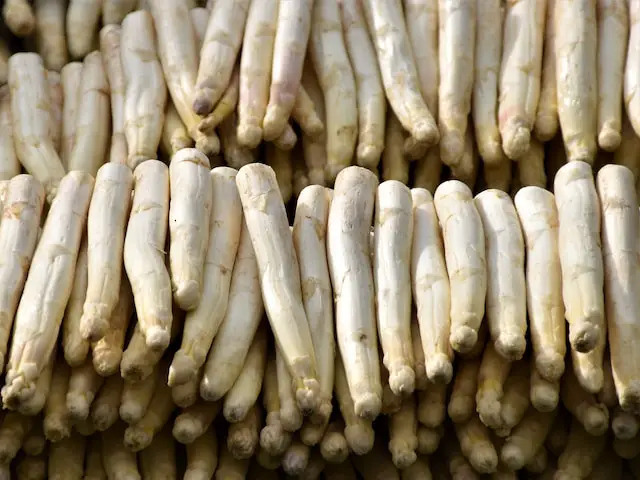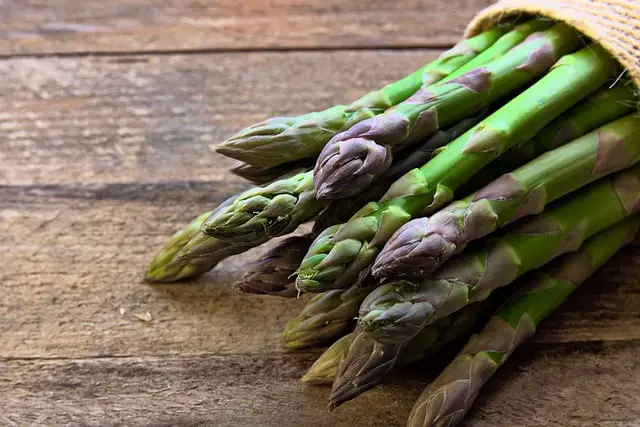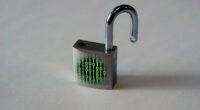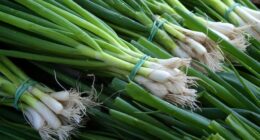White asparagus is grown underground and protected from sunlight, resulting in its pale color and milder flavor. Green asparagus is grown above ground and exposed to sunlight, which gives it a vibrant green color and a slightly grassy taste.
TL;DR White asparagus Vs. Green asparagus
TL;DR: White asparagus is grown underground and has a milder flavor, while green asparagus is grown above ground and has a more pronounced taste.
Green asparagus is more popular globally, but white asparagus is highly prized in certain European countries.
Both types are nutritious and offer vitamins, minerals, and fiber. To cook asparagus, you can boil, steam, roast, or grill it for a delicious and healthy side dish.
White asparagus

White asparagus, also known as “white gold,” is a delicacy that has been prized for centuries. White asparagus is grown underground to protect it from the sun’s rays. This unique cultivation process results in a pale ivory color and a more delicate flavor. White asparagus boasts a smooth and creamy texture with tightly closed tips.
The flavor profile of White asparagus is often described as milder, sweeter, and less bitter than green asparagus. It has subtle earthy notes that make it an excellent addition to various dishes.
Green asparagus

Green asparagus, also known as garden asparagus, is a vibrant and flavorful vegetable that is enjoyed by many. Green asparagus has a distinct appearance and taste that sets it apart.
Green asparagus grows above ground exposed to sunlight, which gives it its characteristic green color. In terms of taste, green asparagus offers a slightly nutty flavor with a hint of sweetness. It has a crisp texture when cooked properly, making it an excellent addition to salads or simply enjoyed on its own.
White asparagus Vs. Green asparagus – Key differences
| Aspect | White Asparagus | Green Asparagus |
|---|---|---|
| Color | Pale white to creamy | Green |
| Growing method | Grown covered with soil | Grown exposed to sunlight |
| Flavor | Mild and slightly nutty | Earthy and grassy |
| Texture | Tender and delicate | Crisp and firm |
| Bitterness | Less bitter | Slightly bitter |
| Cooking time | Longer cooking time | Shorter cooking time |
| Preparation | Requires peeling | Edible from tip to end |
| Nutrition | Slightly higher in carbohydrates and fiber | Slightly higher in vitamins C and E, and folate |
| Availability | Less common | More common |
| Culinary use | Often served in gourmet dishes | Versatile, can be used in various recipes |
| Cultural significance | More popular in certain European countries, such as Germany and France | Widely consumed worldwide |
White asparagus Vs. Green asparagus – The difference in taste
White asparagus and green asparagus have distinct taste profiles due to their growing methods and exposure to sunlight.
White Asparagus
- Taste: White asparagus has a milder and more delicate flavor compared to green asparagus.
- Growing Method: It is grown underground, shielded from sunlight, which prevents the production of chlorophyll, the green pigment responsible for the grassy taste found in green asparagus.
- Texture: White asparagus tends to be more tender and has a smoother texture.
- Bitterness: It is less bitter than green asparagus, making it appealing to those who prefer a subtle taste.
Green Asparagus:
- Taste: Green asparagus has a more pronounced and earthy flavor with slight nutty notes.
- Growing Method: It is grown above ground and exposed to sunlight, allowing it to produce chlorophyll, which gives it the vibrant green color and distinct taste.
- Texture: Green asparagus is firmer and slightly fibrous compared to white asparagus.
- Bitterness: It may have a mild bitterness, which some people appreciate as it adds depth to its flavor.
White asparagus Vs. Green asparagus – The difference in nutrition
| Nutrient | White Asparagus (1 cup, cooked) | Green Asparagus (1 cup, cooked) |
|---|---|---|
| Calories | 70 | 40 |
| Carbohydrates | 13g | 8g |
| Fiber | 6g | 4g |
| Protein | 5g | 4g |
| Fat | 0.2g | 0.4g |
| Vitamin A | 33% of DV | 20% of DV |
| Vitamin C | 32% of DV | 24% of DV |
| Vitamin E | 18% of DV | 7% of DV |
| Vitamin K | 57% of DV | 55% of DV |
| Folate (Vitamin B9) | 66% of DV | 34% of DV |
| Potassium | 16% of DV | 8% of DV |
DV = Daily Value
Please note that the nutritional values are approximate and can vary slightly based on factors such as cooking methods and asparagus size.
White asparagus Vs. Green asparagus – Which asparagus is more popular?
The popularity of white asparagus versus green asparagus can vary depending on the region and cultural preferences. Below is a general overview of their popularity in different parts of the world:
White Asparagus
- White asparagus is more popular in certain European countries, especially in Germany, France, Belgium, and the Netherlands. These countries have a strong tradition of cultivating and consuming white asparagus.
- In these regions, white asparagus is often considered a delicacy and is highly sought after during its relatively short seasonal availability.
- It is also popular in some parts of Asia, such as in Japan and China.
Green Asparagus
- Green asparagus is generally more popular and widely consumed worldwide compared to white asparagus.
- It is commonly found in North America, South America, Australia, and many Asian countries.
- Green asparagus is often more readily available throughout the year, as it can be harvested for a longer period due to its ability to photosynthesize and grow above ground.
Green asparagus tends to be more popular globally due to its wider availability and longer harvest season. However, white asparagus holds significant cultural importance and enjoys a dedicated following in specific European regions where it is considered a seasonal delicacy.
White asparagus Vs. Green asparagus – Which asparagus is better for you?
Both white asparagus and green asparagus are nutritious vegetables and offer various health benefits. The “better” option between the two depends on individual dietary needs and preferences.
White Asparagus
- Contains slightly more calories, carbohydrates, and fiber compared to green asparagus.
- Rich in vitamins A, C, E, K, and folate (Vitamin B9), making it an excellent choice for promoting healthy skin, immune function, and supporting fetal development during pregnancy.
- Higher in potassium, which is essential for maintaining healthy blood pressure and muscle function.
Green Asparagus
- Lower in calories and carbohydrates, making it suitable for those on low-calorie or low-carb diets.
- Contains good amounts of vitamins A, C, E, K, and folate, providing similar health benefits to white asparagus, albeit in slightly lower quantities.
- Slightly higher in certain phytonutrients due to its exposure to sunlight during growth.
Both types of asparagus offer a range of vitamins, minerals, and fiber, contributing to a healthy diet. The differences in their nutritional profiles are relatively minor, and both can be valuable additions to a balanced eating plan.
The choice between white and green asparagus ultimately comes down to personal taste preferences and culinary uses.
To maximize the nutritional benefits, it’s essential to prepare asparagus in a healthy way, such as steaming, roasting, or grilling, rather than frying or cooking with excessive added fats or sauces.
Including a variety of vegetables, including both white and green asparagus, in your diet is an excellent way to ensure you get a wide array of nutrients.
How to cook asparagus
Cooking asparagus is quite simple, and there are several methods you can use to prepare this delicious vegetable. Here are some popular ways to cook asparagus:
Boiling
- Trim the tough ends of the asparagus spears.
- Bring a pot of salted water to a boil and add the asparagus.
- Cook for 2 to 4 minutes, depending on the thickness of the asparagus spears. They should be tender but still crisp.
- Drain the asparagus and immediately transfer them to a bowl of ice water to stop the cooking process and preserve their vibrant green color.
- Serve as-is or with your preferred seasoning or sauce.
Steaming
- Trim the tough ends of the asparagus spears.
- Place a steamer basket over a pot of boiling water, making sure the water does not touch the bottom of the basket.
- Add the asparagus to the steamer basket and cover the pot.
- Steam for 3 to 5 minutes until the asparagus is tender-crisp.
- Remove from the steamer and season as desired before serving.
Roasting
- Preheat your oven to 425°F (220°C).
- Trim the tough ends of the asparagus spears.
- Toss the asparagus with olive oil, salt, and pepper in a baking dish or on a baking sheet, ensuring they are evenly coated.
- Roast in the oven for about 10-15 minutes, depending on the thickness of the asparagus, until they are tender and slightly browned.
- You can add some grated Parmesan cheese or a squeeze of lemon juice for added flavor before serving.
Grilling
- Preheat your grill to medium-high heat.
- Trim the tough ends of the asparagus spears and lightly coat them with olive oil.
- Grill the asparagus for about 2-3 minutes per side until they have grill marks and are tender.
- Season with salt, pepper, and any other preferred spices before serving.
Remember to adjust cooking times based on the thickness of the asparagus spears. Thinner spears will cook faster, while thicker ones will take a bit longer. Avoid overcooking asparagus to maintain its bright color and crisp texture.
Enjoy the delicious taste and nutritional benefits of cooked asparagus as a side dish or part of various recipes.
Image Credits
Featured Image By – macroworlds from Pixabay
Image 1 By – Waldemar on Unsplash
Image 2 By – Taken from Pixabay








